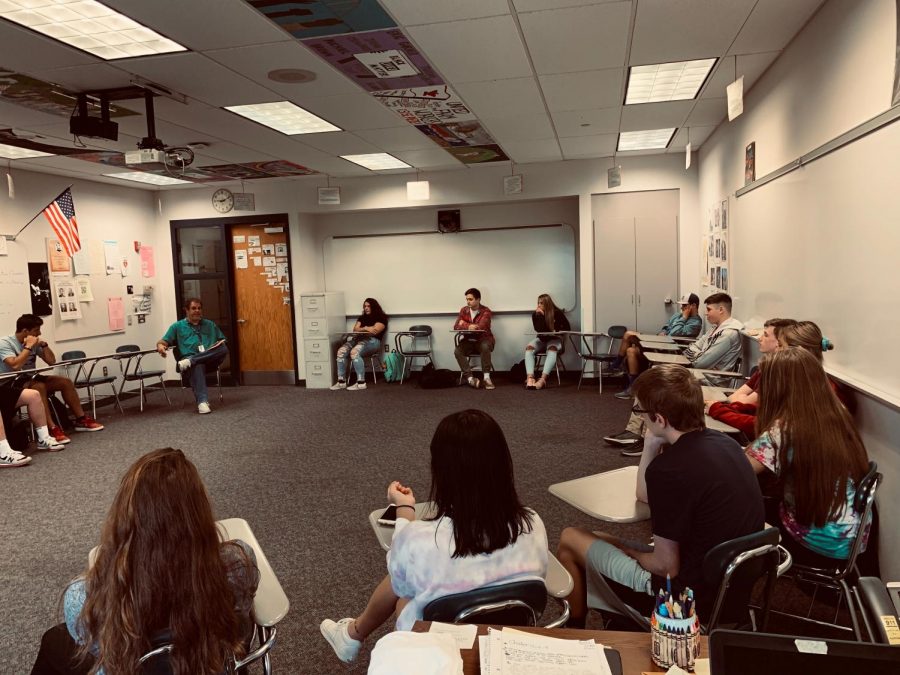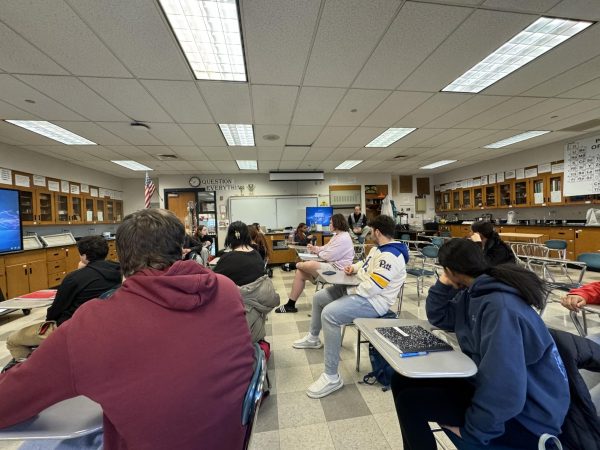OPINION: Smaller class sizes can create success
Students have more opportunities to connect with teachers and meet classmates in smaller classes.
Dr.Hall’s 3rd period class engages in a group discussion.
In most high school hallways, students walk past knowing almost everyone’s name and can point out the kids who were in their 7th grade English class, or who they used to share fruit snacks with in elementary school. However, for North Penn High School students, the hallways are filled with complete strangers.
With students traveling from thirteen elementary schools to three middle schools and eventually ending up at one high school, the community of North Penn is home to many thousands of students. North Penn High School is known for being one of the biggest public high schools in the state. Taking into account that North Penn is home to only grades 10-12, the astounding population of almost 3,200 kids seems crazy to some. With a big school comes big classes filled with many students. Even though the vast amounts of students create a big community, the size of the classes can be a little too much for some students.
“Personally, I would prefer a smaller class size because then everyone in the class can work together and get to know each other better,” stated senior Sophie Collins.
In classes with around 26-30 students, it can be hard to grab the teacher’s attention or be able to fully participate in the class. Students may feel drowned out by their peers; they can feel invisible when surrounded by many other students, and that they aren’t getting the attention they need to succeed. Former North Penn student Noah Walton, who is now a senior at Lansdale Catholic High School, felt the pressure to succeed in such a big environment. Walton traded in his sword and shield after his freshman year to become a Crusader. Downsizing schools benefited Walton; he considers smaller class sizes an advantage.
“Lansdale Catholic has about twenty students per class. Everyone knows [each other], which is nice, and everyone is friendly to one another. It is also easier to ask teachers for help [in a smaller class],” responded Walton.
Not only can bigger classes put stress students, but they can also put stress on their grades. According to an experiment called Project STAR, also known as the Tennessee Study, students who were randomly placed in smaller sized classes performed 8% better on a reading test than other students who were randomly put into classes of 25-30 students. A student’s education suffers more than we think when placed in a classroom with 25-30 other students.
“In my Introduction to Education class, there are only nine people. I like it because I feel like we are all friends and it makes for a better learning experience, since there are fewer kids competing for the teacher’s attention and help,” recalled Casey Neilsen, a student in a dual enrollment course through Montgomery County Community College.
Creating more classrooms with fewer students isn’t as easy as it sounds. In order to create more classes with a smaller amount of students, more teachers are needed to teach those extra courses. In school districts where the budget is tight and can’t budge for additional needs like extra teachers and administrators, downsizing classes and hiring more teachers may not be on the agenda.
Though bigger class sizes can hurt students who need a smaller setting to learn more effectively, bigger class sizes can have their advantages as well. As most seniors get ready for college, having bigger classes prepares them for college classrooms after high school.
“I went to Muhlenberg, which is a small school, smaller than North Penn, and I was so much better prepared for the college experience than my friends who went to smaller schools, because I learned how to fend for myself. I had a diverse student population that I interacted with. I just had a lot more experiences in a bigger school that prepared me for college,” remembered English teacher Elizabeth Weizer.
Having a graduating class of over a thousand students can bring even more advantages to students than they may realize. For instance, each student is given a class rank, which changes depending on the rigor of that student’s classes and the grades that they receive. Being in a pool of a thousand students can be an advantage to the kids who take part in higher-level courses.
“Having a graduating class of a thousand students really helps my rank because not everyone takes the same level classes as me, so it helps a lot to separate everyone and makes it easier for me to have a better rank than the other kids who aren’t taking as higher-level classes as me or who aren’t earning the same grades that I am,” stated senior Megan Cleary, who has been taking Honors-level classes since she was in middle school.
In some cases, large class sizes can hinder a student’s learning experience and make it harder to connect in the classroom. However, it does possess a lot of beneficial advantages. Having thousands of students in our school district is representative of who we are as a district: a growing and diverse community. Regardless of one’s stance on the issue, as students of North Penn walk past strangers in the hallway, it opens up opportunities to make new friendships and to make connections with fellow students and peers, which may be the most important thing about high school.












